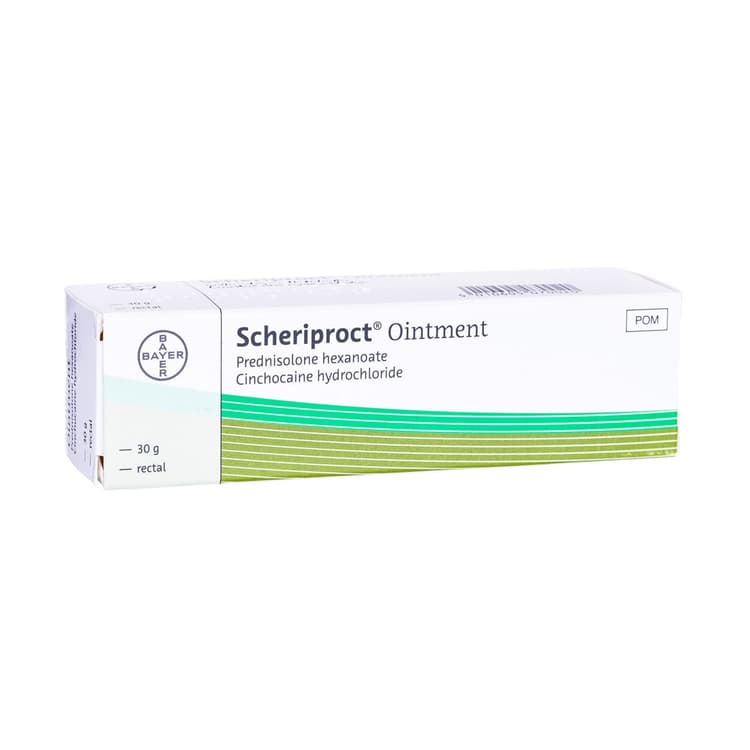Christmas Delivery: Please note orders placed after 2:30pm on 18th December may be delivered after Christmas.
- Home
- General Health
- Haemorrhoids/Piles Treatment
- Scheriproct Ointment (Prednisolone Hexanoate)
Scheriproct Ointment (Prednisolone Hexanoate)

Images for illustrative purposes only
Start Your Expert Consultation
Scheriproct is an ointment especially made to cure external piles, haemorrhoids, and anal itching. Scheriproct ointment affords short term relief for 5 to 7 days for symptoms of haemorrhoids, pruritus and, proctitis, anal fissures, and itching of the anal area.
- Contains a local anaesthetic to reduce sensitivity
- Relieves redness, itching and pain
- Fast acting
- Genuine medication
- All drugs sourced in the UK
More information
A Doctor's Overview
 | GP and surgeon, Dr Shane Charles (MBBS, MRCS, PgDip SEM) provides a simple explanation of the medication below: 'Scheriproct is a medication that is used for relief of symptoms related to piles or hemorrhoids. '. If you think this is a treatment that can help you, start an online consultation now for a registered prescriber to review. If treatment is deemed suitable, they can prescribe it, and we can deliver it to you from the comfort of your own home with a range of convenient delivery and payment options for you to choose from. If you have any questions about a medication, you should always consult your doctor with any questions prior to starting treatment, to ensure that it is safe and suitable for you. |
What Is Scheriproct ointment?
Scheriproct ointment ointment
Scheriproct ointment is an ointment made to cure external piles, haemorrhoids, and anal itching. The medication affords short term relief for 5 to 7 days for symptoms of haemorrhoids, pruritus and, proctitis, anal fissures, and itching of the anal area.
Patient Information Leaflet
For more information on the prescription medication patients should refer to the Scheriproct ointment patient information leaflet.
How does Scheriproct ointment work?
The Scheriproct ointment like the suppositories is manufactured with two leading ingredients they are the Prednisolone and Cinchocaine. Cinchocaine is a kind of drug that is referred to by many medical practitioners as a local anaesthetic. It helps by essentially blocking away the pain messages sent on the nerve fibres. It helps numb the painful area where the medication has been applied thus affording quick relief from pain and or itching brought about by pruritus and, haemorrhoids, and anal fissures.
Prednisolone is a kind of drug referred to as ‘Corticosteroid’ and is utilised basically for preventing inflammation. They work by simply inhibiting cells from releasing some substances that can make blood vessels to expand and become irritated, swollen, itchy, and even painful. Once applied to the infected area, the prednisolone works locally to help minimize the swelling, pain, and itching.
What are the benefits of Scheriproct ointment ointment?
Scheriproct ointment helps patients deal with the signs and symptoms of pruritus and, haemorrhoids, anal fissures, proctitis, and itching of the anal area. The two major components prednisolone and cinchocaine are responsible in offering quick relief for people suffering from the aforesaid ailment. A topical ointment applied to the rectum helps to ease symptoms of haemorrhoids and associated diseases that leads to swelling, pain, and itching. In as little as five to seven days, complete relief is achieved with consistent use of the ointment.
How do I use Scheriproct ointment ointment?
When applying the Scheriptoct ointment for the very first time, there are some easy to follow instructions patients must adhere to. First of all, make sure you wash your hands thoroughly before and after applying the topical ointment. Unlike the cream, the suppository variant is used by simply inserting it on the rectum area about one day after defecation. If your anal itching and piles are very painful and severe, your prescriber will recommend you use a suppository instead of the topical treatment. The suppository will be used for about three times a day or as directed by your physician.
When applying the ointment, a tiny amount will be applied and used in the day and night, after the patient has moved bowel. For severe and worst cases, the prescriber will recommend using the topical treatment to up to 4 times daily for the first day of use. Take a pea-sized ointment and apply it thinly on the anal area with the help of your fingers or you can use the product nozzle to help insert a tiny portion of the ointment into the back passage. When applying using the nozzle, the nozzle of the Scheriptoct ointment must be tightly screwed to the body of the ointment tube. Then, gently squeeze the tube until such time that the ointment nozzle is filled with the ointment. Gently insert the nozzle into the rectum of the patient and squeeze out the contents lightly. Withdraw the nozzle very slowly, and then make sure you thoroughly clean the nozzle with soap and water after every use. Wash your hands thoroughly as well. Never cover the area that was treated with Scheriptoct ointment with any waterproof dressing or bandage. This includes adding nappy to children if the Scheriptoct ointment was prescribed for use by them. Scheriptoct ointment must not be used for longer than 7 days at a given treatment time. If your symptoms persist, or your medical condition has not developed with Scheriptoct ointment contact your prescriber for further assistance.
What is the correct dosage of Scheriproct ointment ointment?
The Scheriptoct ointment is available in 30 grams and 10 grams tube of ointment. The primary ingredients included in the Scheriptoct ointment are PEG-8 ricinoleate, Prednisolone Hexanoate 1.9mg/g, Cinchocaine Hydrochloride 5mg/g, Octyldodecanol, Castor Oil, Hydrogenated Castor Oil, and Perfume Oil Chypre.
Unless otherwise stated, Scheriptoct ointment must be applied only twice daily. The application of up to 4 times a day for the initial use can offer fast relief. Apply a pea-sized portion of the ointment around the anal area and just inside the anus. Or you can use the nozzle supplied with the tube that is screwed to the Scheriptoct ointment and this is applied internally. However, if the anus is very inflamed and worse, you should apply the Scheriptoct ointment internally using your finger.
The treatment will have to be continued for one week, for once a day after the symptoms of pruritus and have cleared. The total time of treatment must not exceed up to 4 weeks. If you happen to forget to use the Scheriptoct ointment, use it as soon as you recall and then resume to the normal times of applying the ointment. Never try to make up for the amount you missed by doubling the dosage and more than you usually would do. If you are unsure, always ask your doctor, nurse, or pharmacist for assistance.
Should you have any trouble recalling the use of Scheriptoct ointment, ask your doctor for some help on how you can ensure you remember using it on time.
What side effects can Scheriproct ointment have?
Medications and other adverse effects can impact individuals in various ways. Like any other medicines, Scheriptoct ointment has its own negative side effects to users, although not all have experienced the same side effects. The following are the most common side effects that are associated with the use of Scheriptoct ointment. They are:
- Allergic reactions
- Thinning of the skin in the rectal area if used for an extended period of time
If you experience any of this side effects, or if you have undergone other side effects not listed here, you must immediately consult with your doctor, nurse, or pharmacist to inform them right away of your condition.
Those who must avoid using Scheriproct ointment ointment:
- Those with an allergy to any ingredients found on Scheriproct ointment ointment
- Those who are allergic to local anaesthetics
- Those with viral infections (HIV, STD, etc.)
- Those with bacterial infection
- Those with fungal infection
Always check the product leaflet information to know other contraindications of the Scheriptoct ointment.
Always inform your doctor if you are breastfeeding, pregnant, intends to be pregnant, or there is a possibility of being pregnant before you use Scheriptoct ointment. The ingredient corticosteroids that are in the ointment may be absorbed into the bloodstream after use on the anal area and it can cause adverse effects on fetal development. If you are considering using Scheriptoct ointment, always consult a doctor before using it.
Do not use if -
- You have TB
- You have Syphillis
- You have a viral disease like Chickenpox or HIV
- You have trauma in the skin
- You have thrush or fungal skin infection unless you are being treated for it and you have your
doctor’s approval
- You have allergic reactions to drugs as cinchocaine hydrochloride or Prednisolone hexanoate
- You have allergic reactions to the ingredients of Scheriproct ointment that are found listed on the product information leaflet.
A pharmacist's overview of the side effects of this medication and how to manage them:
 | Senior Specialist Pharmacist, Dania Al-Zarrad, provides a simple explanation of the common side effects of the medication and how you can manage them: Can cause local irritation and burning, with skin thinning in prolonged use; apply short term. |
How do I buy Scheriproct ointment online?
You can safely buy Scheriproct ointment online at UK Meds. You will first need to have an online consultation with a pharmacist independent prescriber before your order will be supplied. The online consultation will ensure that Scheriproct ointment is the right medication for your medical condition.
Can you get Scheriproct ointment at Boots?
Scheriproct ointment Boots
No. At the time of writing, Scheriproct ointment is not available at Boots. However, should you wish to purchase Scheriproct, you can do so at UK Meds. Additionally, if you would like to purchase more than one tube of Scheriproct ointment ointment, you can benefit from further savings at UK Meds.
Can you get Scheriproct ointment at Amazon?
Scheriproct ointment Amazon
No. At the time of writing, Scheriproct ointment is not available at Amazon. However, should you wish to purchase Scheriproct, you can do so at UK Meds. Additionally, if you would like to purchase more than one tube of Scheriproct ointment ointment, you can benefit from further savings at UK Meds.
Here to help you
Our Customer Service is available Monday to Friday 9am - 5pm. If you need urgent assistance, do not use this service. Call 111, or in an emergency call 999. Visit our help section


